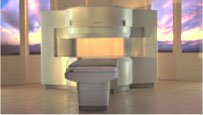 | Info
Sheets |
| | | | | | | | | | | | | | | | | | | | | | | | |
 | Out-
side |
| | | | |
|
| | | | |
Result : Searchterm 'Fringe Field' found in 3 terms [ ] and 62 definitions [ ] and 62 definitions [ ] ]
| 1 - 5 (of 65) nextResult Pages :  [1] [1]  [2 3 4 5 6 7 8 9 10 11 12 13] [2 3 4 5 6 7 8 9 10 11 12 13] |  | | |  |  |  |
| |
|
| |  | | | | • Share the entry 'Fringe Field':    | | | | | | | | | |  Further Reading: Further Reading: | Basics:
|
|
| |
|  | |  |  |  |
| |
|
This line specifies the perimeter around a MR scanner within which the static magnetic fields are higher than five gauss. Five gauss and below are considered 'safe' levels of static magnetic field exposure for the general public.
Due to the physical properties of magnetic fields, the magnetic flux, which penetrates the useful volume of the magnet will return through the surroundings of the magnet to form closed field lines. Depending on the magnet construction, the returning flux will penetrate large open spaces (unshielded magnets) or will be confined largely to iron yokes or through secondary coils (shielded magnets). | |  | |
• View the DATABASE results for '5 Gauss Fringe Field' (4).
| | | | |  Further Reading: Further Reading: | | Basics:
|
|
News & More:
| |
| |
|  | |  |  |  |
| |
|
The region surrounding a magnet and exhibiting a magnetic field strength, which is significantly higher than the earth's magnetic field (typically 0.05-0.1 mT, depending on geographical location).
Initially the most magnets had very extensive fringe fields. Magnets with iron have reduced the fringe field substantially (passively shielded magnets). At least, adding appropriate additional superconducting coils to superconducting magnets has resulted in a drastic reduction of the extent of the fringe fields (actively shielded magnets).
Due to the physical properties of magnetic fields, the magnetic flux, which penetrates the useful volume of the magnet will return through the surroundings of the magnet to form closed field lines. Depending on the magnet construction, the returning flux will penetrate large open spaces (unshielded magnets) or will be confined largely to iron yokes or through secondary coils (shielded magnets).
Fringe fields constitute one of the major hazards of MR scanners as these fields acting over extended distances outside the magnet produce strong attractive forces upon magnetic objects. These can thus 'fly' into the magnet when loose nearby acting like projectiles. Fringe fields also exert unwanted forces on metallic implants in patients. | |  | |
• View the DATABASE results for 'Magnetic Fringe Field' (3).
| | | | |  Further Reading: Further Reading: | Basics:
|
|
| |
|  | |  |  |  |
| |
|
A type of magnet that utilizes the principles of electromagnetism to generate the magnetic field. Typically large current values and significant cooling of the magnet coils is required. The resistive magnet does not require cryogens, but needs a constant power supply to maintain a homogenous magnetic field, and can be quite expensive to maintain.
Resistive magnets fall into two general categories - iron-core and air-core.
Iron-core electromagnets provide the advantages of a vertically oriented magnetic field, and a limited fringe field with little, if any, missile effects due to the closed iron-flux return path.
Air-core electromagnets exhibit horizontally oriented fields, which have large fringe fields (unless magnetically shielded) and are prone to missile effects. Resistive magnets are typically limited to maximum field strengths of approximately 0.6T. | |  | |
• View the DATABASE results for 'Resistive Magnet' (3).
| | | | |
|  | |  |  |  |
| |
|

From Hitachi Medical Systems America Inc.;
the AIRIS II, an entry in the diagnostic category of open MR systems, was designed by Hitachi
Medical Systems America Inc. (Twinsburg, OH, USA) and Hitachi Medical Corp. (Tokyo) and is manufactured by the Tokyo branch. A 0.3 T field-strength magnet and phased array coils deliver high image quality without the need for a tunnel-type high-field system, thereby significantly improving patient comfort not only for claustrophobic patients.
Device Information and Specification
CLINICAL APPLICATION
Whole body
QD Head, MA Head and Neck, QD C-Spine, MA or QD Shoulder, MA CTL Spine, QD Knee, Neck, QD TMJ, QD Breast, QD Flex Body (4 sizes), Small and Large Extrem., QD Wrist, MA Foot and Ankle (WIP), PVA (WIP)
SE, GE, GR, IR, FIR, STIR, FSE, ss-FSE, FLAIR, EPI -DWI, SE-EPI, ms - EPI, SSP, MTC, SARGE, RSSG, TRSG, MRCP, Angiography: CE, 2D/3D TOF
IMAGING MODES
Single, multislice, volume study
TR
SE: 30 - 10,000msec GE: 20 - 10,000msec IR: 50 - 16,700msec FSE: 200 - 16,7000msec
TE
SE : 10 - 250msec IR: 10 -250msec GE: 5 - 50 msec FSE: 15 - 2,000
0.05 sec/image (256 x 256)
2D: 2 - 100 mm; 3D: 0.5 - 5 mm
Level Range: -2,000 to +4,000
POWER REQUIREMENTS
208/220/240 V, single phase
COOLING SYSTEM TYPE
Air-cooled
2.0 m lateral, 2.5 m vert./long
| |  | |
• View the DATABASE results for 'AIRIS II™' (2).
| | | | |
|  | |  |  |
|  | | |
|
| |
 | Look
Ups |
| |